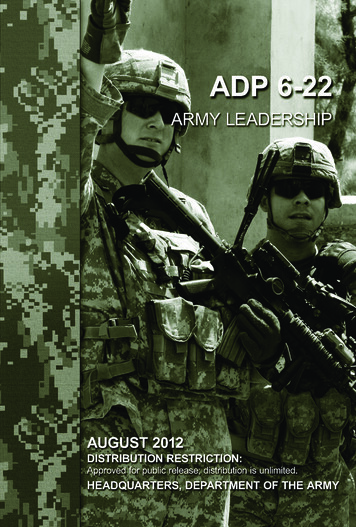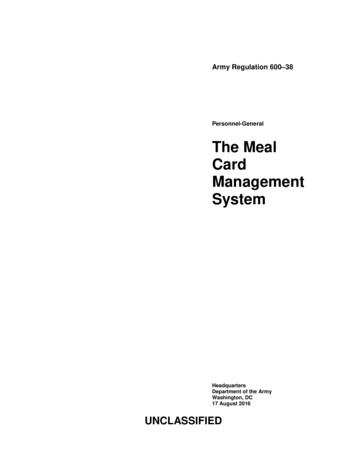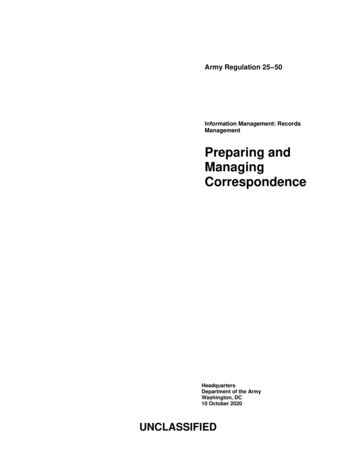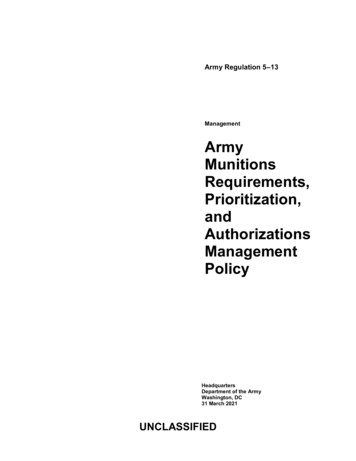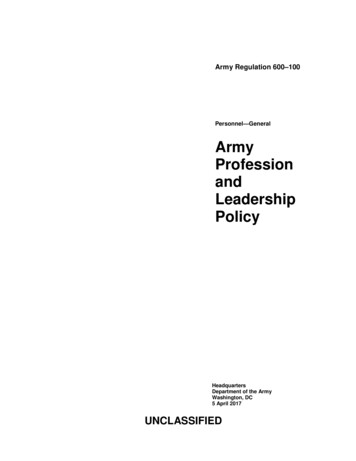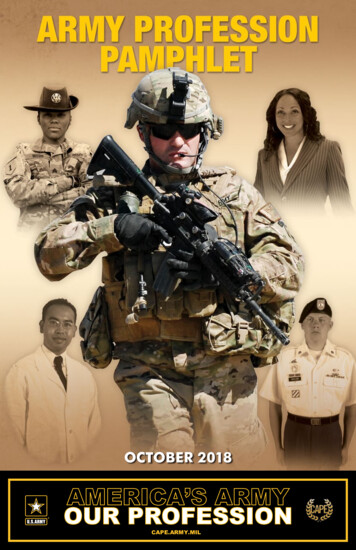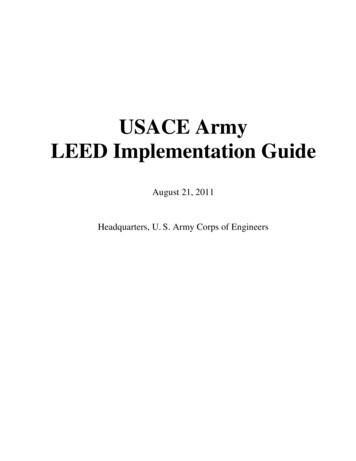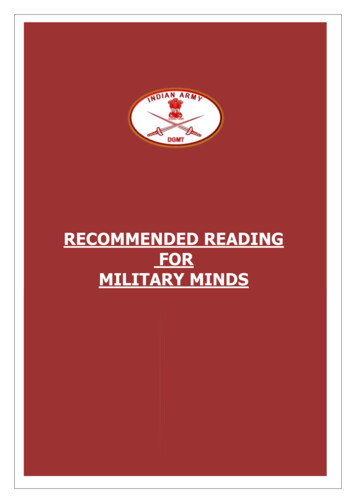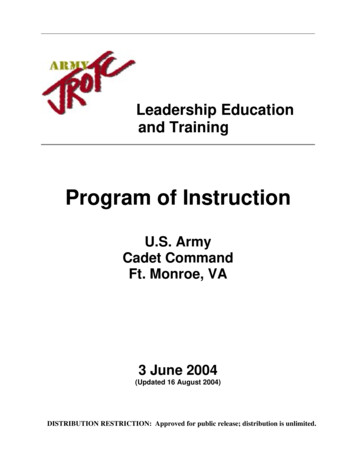
Transcription
Leadership Educationand TrainingProgram of InstructionU.S. ArmyCadet CommandFt. Monroe, VA3 June 2004(Updated 16 August 2004)DISTRIBUTION RESTRICTION: Approved for public release; distribution is unlimited.
A TOAST TO THE FLAGby John J. DalyHere’s to the red of itThere’s not a thread of it,No, nor a shred of itIn all the spread of itFrom foot to head,But heroes bled for it,Faced steel and lead for it,Precious blood shed for it,Bathing it Red!Here’s to the white of itThrilled by the sight of it,Who knows the right of itBut feels the might of itThrough day and night?Womanhood’s care for itMade manhood dare for it,Purity’s prayer for itKeeps it so white!Here’s to the blue of itBeauteous view of it,Heavenly hue of it,Star-spangled dew of itConstant and true;Diadems gleam for it,States stand supreme for it,Liberty’s beam for itBrightens the blue!Here’s to the whole of itStars, stripes and pole of it,Body and soul of it,O, and the roll of it,Sun shining through;Hearts in accord for it,Swear by the sword for it,Thanking the Lord for it,Red White and Blue!Contributed byLTC George W. GehrSenior Army InstructorFort Knox High School
Course: ROTC 145-4Course Name: Junior Reserve Officers’ Training Corps (JROTC) andNational Defense Cadet Corps (NDCC)Preparation Date: 28 April 2004Optimum Class Size: 20Program of Instruction Cover PageTotal Computed Academic Hours: 720 (180 hours per year for four years)Approval Authority: U.S. Army Cadet Command, Junior Reserve Officers’ Training CorpsDirectorateApproval Date:3 June 2004Supersedes: This POI supersedes POI dated 01 February 2002.Minor Changes and Additions: Changes and additions that do not substantially alter the intentof this Program of Instruction (POI) will be posted on the JROTC web portal. The changes andadditions should be annotated where needed and the original notice kept behind the POI in theInstructor Desk Reference.1-1
Course: ROTC 145-4Course Name: Junior Reserve Officers’ Training Corps (JROTC) andNational Defense Cadet Corps (NDCC)Preparation Date: 26 May 2004Optimum Class Size: 20Table of ContentsPOI Cover Page. 1-1Total Computed Academic HoursApproval AuthorityApproval DateSuperseded POI DateInstructions for Minor Changes and AdditionsPreface. 2-1StatusTraining Location(s)PurposeCollaborationCourse Scope . 2-4Student Learning OutcomesProgram Learning OutcomesCore AbilitiesCompetenciesNational StandardsCourse Prerequisites . 2-7Course LengthAcademic HoursClass SizesInstructor/Student RatioSpecial Information . 2-8Training Start DateProponentCourse RemarksHow to Use this Curriculum . 2-9What is Performance-based learning? Assessment, Learning, TeachingWhat Curriculum Tools Does the JROTC Program Provide? . 2-10Lesson PlansLearning PlansAssessment TasksLearning MaterialsSchool Already Offers One of the Components of the JROTC Curriculum . 2-12Course Summary . 3-1Required Lessons (Table A)Scheduling OptionsCourse Summary for Accelerated Block (Table B). 3-2Notes for Tables – Specific Required Lessons, Lesson Structure, Required Electives,LET 4 Mandatory Options, Reduced Hours, Marksmanship SafetyElectives Table (Table C) . 3-3Training Units and Chapters . 4-1Course Descriptions . 5-1
Course:ROTC 145-4Course Name: Junior Reserve Officers’ Training Corps (JROTC) and National Defense Cadet Corps (NDCC)Preparation Date: 2 June 2004Optimum Class Size: 20PrefaceStatus: Directorate ApprovedTraining Three- or four-year high schoolsLocation(s):Purpose: The JROTC/NDCC (Junior Reserve Officer Training Corps/National DefenseCadet Corps) program is hereafter referred to as simply the JROTC program,although provisions of this document are still applicable to the NDCCprogram. It is designed to teach high school students the value of citizenship,leadership, service to the community, personal responsibility, and a sense ofaccomplishment, while instilling in them self-esteem, teamwork, and selfdiscipline.The program’s focus is reflected in its mission statement, “To motivate youngpeople to be better citizens.” It prepares high school students for responsibleleadership roles while making them aware of their rights, responsibilities, andprivileges as American citizens. The program is a stimulus for promotinggraduation from high school, and it provides instruction and rewardingopportunities that will benefit the student, community, and nation.Collaboration: In the production of this curriculum the Junior ROTC Directorate hasincorporated the latest educational theories used in secondary education.McREL standards have been linked to each lesson to show a crossconnection with this curriculum and the standard curriculum taught in highschool. Consultants were used to validate the changes and to assist in therewriting. Other commercially available materials have been incorporated andmany times the authors of these programs have customized them for theJROTC program. These organizations and programs are: The Worldwide Instructional Design System (WIDS) Team, an educationalgroup operating under the Wisconsin Technical College System Foundation,Inc, provided the model, methodology, and software used to develop coreabilities, competencies, performance standards, and learning plans. TheWIDS Team also updated lesson plans and incorporated the McRELStandards. Student-centered (Intellilearn) learning techniques from the NationalAcademy of Integrative Learning, Inc. (NAIL) have been incorporated inthe lessons and instructor preparation materials. The lesson format is an accepted standard and was provided by Dr. StevenDunn, author of Brain Compatible Learning for the Block. Dr. Dunnprovided training to curriculum work groups and writers; additionally heassisted the writers in the review of the lessons during production.2-1
Course:ROTC 145-4Course Name: Junior Reserve Officers’ Training Corps (JROTC) and National Defense Cadet Corps (NDCC)Preparation Date: 2 June 2004Optimum Class Size: 20 The National Endowment for Financial Education (NEFE) also uses Dr.Dunn’s lesson format, and provides all material for the High SchoolFinancial Planning Program (HSFPP). Written Communication for Sergeants, developed by Susan Hughes is anexcellent resource for students to learn writing skills and to prepare for thewritten portion of the SATs. Winning Colors (WC) by Stefan Nielson and Shay Thoelke of AeonCommunications, Inc., has been used in schools and corporations as apresent time behavioral observation indicator that is readily understandable. The Success Profiler has been integrated in this Program of Instruction incooperation with the Conover Company. It is designed to measure andimprove emotional intelligence. Unlocking Your Potential (UYP), a youth motivational program from EdgeLearning Institute, Inc, is incorporated in many lessons and is used asadditional elective material. Components of the You the People (YTP) curriculum have beenincorporated into the program and Charles Heberle, the author, has workedwith the writers to integrate the process into the lessons. Robert Aucone, the creator and author of Chief Justice, worked closely withU. S. Army Cadet Command to add this active learning program thataddresses the judicial branch. We the People (WTP), developed by the Center for Civic Education topromote civic responsibility in students, is integrated into the Citizenship inAmerican History and Government lessons. Interactive Nights Out 2, produced by Will Interactive, Inc., is integratedinto the drug awareness lessons. Hate Comes Home and Just 2 Days also produced by Will Interactive, areintegrated into conflict resolution lessons. Saving SGT Pabletti was developed for the Army by Will Interactive tocreate an awareness of sexual harassment in a unit. It is available for use bythe Senior and Junior ROTC cadets at the discretion of the Professor ofMilitary Science and JROTC instructors. It emphasizes the importance ofArmy values. In Real Life: Sexual Harassment in Schools, by Concentrics, Inc., providesinsight into how to recognize and resolve incidents of sexual harassment.2-2
Course:ROTC 145-4Course Name: Junior Reserve Officers’ Training Corps (JROTC) and National Defense Cadet Corps (NDCC)Preparation Date: 2 June 2004Optimum Class Size: 20 Lions-Quest is a comprehensive, values based, program that focuses on apositive prevention approach and a broad range of life skills that can beconsistently taught and reinforced. Lions-Quest Service Learning is ateaching strategy that facilitates skills-based classes and the successfulexecution of a service-learning program. Thinking Maps by Innovative Learning Group create a common visuallanguage that promotes integrated thinking and interdisciplinary learning.Eight graphic organizer-like maps are used to teach specific thoughtprocesses across disciplines and LET levels. Classroom Performance System (CPS) by e-Instruction is a technologybased productivity tool used for direct instruction, assessment, evaluationand management. It promotes active learning with full student engagementand participation.2-3
Course:ROTC 145-4Course Name: Junior Reserve Officers’ Training Corps (JROTC) and National Defense Cadet Corps (NDCC)Preparation Date: 2 June 2004Optimum Class Size: 20Course Scope: This Program of Instruction (POI) focuses on the development of bettercitizens by building skill in leadership, citizenship, life success, geography,and wellness, in a structured interactive environment.The JROTC program is a cooperative effort on the part of the Army and thehost institution to provide secondary school students with opportunities fortotal development. The flexibility of the program allows it to bear the scrutinyof professional educators and to meet the needs of the community. Satisfactorycompletion of the program can lead to advanced placement credit in the SeniorROTC program or advanced rank in the Armed Forces. Several componentsof the course have been identified for college credit that is awarded to cadetsupon successful completion of the specified requirements.The JROTC program is one of the Army’s contributions to assisting America’syouth to become better citizens. The program produces successful studentsand productive adults, while fostering in each school a more constructive anddisciplined learning environment. This program makes substantialcontributions to many communities and ultimately to the nation’s future. It isthe centerpiece of the Department of Defense’s commitment to America’sPromise for Youth through its emphasis on service learning, communityservice and teen anti-drug efforts.Student Program OutcomesLearningOutcomes: This program intends to teach cadets to:1. Maximize potential for success through learning and self-management2. Develop leadership skills3. Incorporate principles of mental and physical wellness into behaviors and4.5.6.7.8.decisionsBuild effective relationships with peers, co-workers, and the communityApply physical and political geography to building global awarenessCorrelate the rights and responsibilities of citizenship to the purposes ofU.S. governmentRelate events in U.S. history to choices and responsibilities Americans havetodayCharacterize the role of the military and other national service organizationsin building a democracy and maintaining peace in a democratic societyThese program outcomes describe what JROTC cadets will know and be ableto do upon successful completion of the JROTC program. They serve as a toolfor summarizing and communicating the intended results of the JROTCprogram. The program outcomes provide the foundation for mastery of the“big picture” proficiencies and help instructors and cadets begin and progress“with the end in mind.”2-4
Course:ROTC 145-4Course Name: Junior Reserve Officers’ Training Corps (JROTC) and National Defense Cadet Corps (NDCC)Preparation Date: 2 June 2004Optimum Class Size: 20Program outcomes can be used, along with core abilities, to communicateover-all learning outcomes to cadets, principals, school boards, parents, andmembers of the community. Instructors use them as a tool for credentialingand showing the value of JROTC when a school or program is under-going reaccreditation.Core Abilities1. Build your capacity for life-long learning2. Communicate using verbal, non-verbal, visual, and written techniques3. Take responsibility for your actions and choices4. Do your share as a good citizen in your school, community, country, andthe world5. Treat self and others with respect6. Apply critical thinking techniquesThe JROTC Core abilities describe the broad, life-long skills that every cadetneeds for success in all career and life roles. They are drawn from the over-allgoals and values that drive the JROTC program. Core abilities are not learnedin one lesson or LET, but rather they are linked to lesson competencies inorder to integrate or thread them throughout the JROTC curriculum.When they teach each lesson, instructors explicitly introduce, teach, reinforce,and assess the core abilities that are designated as particularly relevant to thelesson competency. The core abilities will be displayed prominently in JROTCclassrooms. Cadets should know and be able to recite them early in theirJROTC experience. They should view them as the essential, value-added skillsthat every employer seeks.CompetenciesEach JROTC lesson addresses a competency as the intended learning result.Competencies describe discipline-specific skills, knowledge, and attitudes thatare measurable and observable. Performance standards (criteria andconditions) provide the specifications for assessing mastery of a competency.Cadets show they have learned competencies by applying them in thecompletion of assessment tasks that require them to do one or more of thefollowing: make a decision perform a skill perform a service solve a problem create a productInstructors explicitly introduce, teach, reinforce, and assess the competency asthe learning target for every lesson. They help cadets take responsibility fortheir own learning by directing them to review the competency and its2-5
Course:ROTC 145-4Course Name: Junior Reserve Officers’ Training Corps (JROTC) and National Defense Cadet Corps (NDCC)Preparation Date: 2 June 2004Optimum Class Size: 20performance standards (criteria and conditions) at the beginning of the lesson,pointing out that informing themselves about the performance expectations isthe cadets’ first step towards learning success. Instructors use the competencyas the target for all assessment and the performance standards (criteria andconditions) as the guidelines for evaluating and providing feedback aboutcadet performance.National StandardsThe JROTC curriculum fully or partially addresses a number of the McRELacademic standards:Self RegulationHealthCitizenshipThinking andLanguage ArtsCivicsReasoningLife SkillsEconomicsU.S. HistoryLife WorkGeographyWorking with Others 2003 McRELMid-continent Research for Education and Learning2550 S. Parker Road, Suite 500Aurora, CO sMcRel is a nationally recognized, private, nonprofit organization dedicated toimproving education for all through applied research, product development,and service.The purpose of the McRel standards project is “to address the major issuessurrounding content standards, provide a model for their identification, andapply this model in order to identify standards and benchmarks in the subjectareas.”2-6
Course:ROTC 145-4Course Name: Junior Reserve Officers’ Training Corps (JROTC) and National Defense Cadet Corps (NDCC)Preparation Date: 2 June 2004Optimum Class Size: 20Course (1) Completion of the eighth grade.Prerequisites: (2) For LETs 2-8, completion of a previous LET program. **When LETs 2 and 3 are taught together, LET 3 may be sequenced before LET 2. LET 1 is prerequisiteto both LETs 2 and 3.Course The course length is normally four years at a traditional high school (grades 9 Length: 12). Military institutes require a four-year program. High schools have theoption to conduct a three-year program and are encouraged to use pertinentparts of the LET 4 curriculum.Spring/Summer JROTC Cadet Leadership Challenge is an additional component of thethree- and four-year programs and supplements the JROTC curriculum for selected upperclass cadets. For those attending, additional focus is placed on developing cadets’character and leadership skills, abilities, and potential. Cadets also expand on theirfoundations for success; leadership; wellness; geography; and teaching math and scienceskills.Normal Course Length – Weeks: 104 at 26 per yearHours: 720 at 180 per mal (LET 1-4)520200720Accelerated (LET 5-8)520200720Class Sizes: Optimum: 20Instructor Worst Case – 1:30Student Ratio:2-7
Course:ROTC 145-4Course Name: Junior Reserve Officers’ Training Corps (JROTC) and National Defense Cadet Corps (NDCC)Preparation Date: 2 June 2004Optimum Class Size: 20Special This program consists of up to eight levels of LET instruction and one PreInformation: LET, elective course. The Military Order of World Wars (MOWW) “ProjectHigh School Prep” one-year course is generally used for the Pre-LETinstruction, as outlined in table D. Materials are provided for the traditionalLET 1 to LET 4, and add-on levels of LET 5 to LET 8 for high schools underaccelerated block scheduling. Each level must total 180 academic hours or thenumber of academic hours required to meet the curriculum requirements for1.0 credit in courses such as Math or English. Host institutions are required toaward credit toward graduation for each year of the JROTC program.The curriculum is aligned to the MCREL national standards. The POI providesthe flexibility to meet the standards for additional credit, other than elective, insubject areas such as Physical Education, Health, Wellness, Life ManagementSkills, Freshman Orientation, Government, Civics, Practical and PerformingArts, Careers, etc.Instructors can teach alone or on teams with teachers licensed in theappropriate areas to earn this credit. JROTC units, in cooperation with hostinstitutions, may also allow credit for college level, honors, and advancedplacement courses in subject areas that are commensurate with this POI. Allschools are encouraged to allow substitution of credit where practical.Schools with low cadet enrollments (50 cadets is the lowest acceptable, 100 iscost effective) need to seek as much substitute credit as possible. Likewise,schools where cadets do not reflect a cross section of the school population ormust leave the program to meet other requirements (especially in the subjectsabove) must permit equivalency credit to the greatest extent possible.Training Start Training is conducted on a school-year basis. In year-round schools, JROTCDate: will follow the school policy in establishing the start of a new school year.Proponent:Design and Development:Course Proponent:Instructor Provided Support:Training Evaluation Proponent:U.S. Army Cadet Command (USACC) JROTCDirectorateUSACC JROTC Directorate/Host High SchoolsUSACC JROTC Directorate, Regions, AreaCoordinators, Brigades/Host SchoolsUSACC JROTC Directorate, Regions, AreaCoordinators, Brigades, JROTC Unit/Host SchoolsCourse JROTC units may elect to conduct a technical program (tailored to supportRemarks: programs such as Cisco Academies and other skills-based career programs), anacademic (traditional) program, or a combination of both programs.JROTC units may also elect to form a band and/or drum and bugle corps at thediscretion/approval of the Senior Army Instructor/Director of ArmyInstruction/Commandant, host institution, and Cadet Command.2-8
Course:ROTC 145-4Course Name: Junior Reserve Officers’ Training Corps (JROTC) and National Defense Cadet Corps (NDCC)Preparation Date: 2 June 2004Optimum Class Size: 20How to Use this CurriculumWhat is JROTCperformancebased learning?To begin with the endin mind means to startwith a clearunderstanding of yourdestination. It meansto know where you’regoing so that youbetter understandwhere you are now sothat the steps you takeare always in the rightdirection.--Stephen CoveyThe Seven Habits ofHighly EffectivePeopleCadet success is the main goal of all JROTC learning experiences. TheJROTC curriculum is based on the principles of performance-based, learnercentered education. Following the stages identified by Grant Wiggins and JayMcTighe, the designers first identified desired results; next they determinedacceptable evidence; and finally they planned learning experiences andinstruction that would be effective in preparing the cadets to achieve thedesired results. (Understanding by Design, p. 9)Learner-centered, performance-based learning specifies desired results(knowledge, skills, and attitudes) in advance of instruction, explicitly statesstandards used to measure performance, requires learners to perform thecompetency as evidence of achievement, and provides learners opportunity todevelop each competency.As a result, cadets: Learn skills they can use; not outlines of information or isolated factsKnow the performance expectations up frontEngage as active partners in the learning processDocument accomplishments and competenceLearn how to learnAssessmentBecause the JROTC curriculum is performance-based, it requires that cadetsmaster the competencies so that they can do the skills, apply the knowledge,and model or exhibit behaviors representing the desired attitudes.To help instructors and cadets determine when cadets have reachedproficiency, each competency is defined by a set of performance standards.The performance standards include conditions for assessment (a statementdescribing what the cadets must do to show proficiency) and criteria(specifications that describe the quality of a proficient performance).The JROTC curriculum requires that cadets demonstrate their mastery of thecompetencies by completing assessments that require them to do one or moreof the following: make a decisionperform a skillperform a servicesolve a problemcreate a productThough multiple-choice, paper-pencil exams may be useful in providingfeedback to cadets about their initial grasp of knowledge and ability toremember facts and information, they are not adequate for the task ofassessing cadet mastery of the competencies. The JROTC program requiresthat cadets document mastery of the competencies by completing theperformance assessment tasks included in the curriculum, or by completingan adaptation of the assessment task. (Adaptations should be rated using a2-9
Course:ROTC 145-4Course Name: Junior Reserve Officers’ Training Corps (JROTC) and National Defense Cadet Corps (NDCC)Preparation Date: 2 June 2004Optimum Class Size: 20scoring guide that includes the criteria for the target competency.)LearningThe JROTC program is intended to engage cadets in active learning. Thismeans that “learner-centered” learning activities should dominate the cadetlearning experience. Learner-centered learning activities place cadets inactive roles in all stages (inquire, gather, process, and apply) of the lesson.This means that cadets should do the work of learning. They should also beactively involved in self and peer assessment (with back-up and feedbackfrom instructors.) Cadets should spend a minimal amount of their learningtime passively listening to a lecture or viewing PowerPoint slides created bythe instructor.TeachingPlacing cadets in the role of active learners, requires that the instructorsassume a supporting role. JROTC instructors should view themselves asfacilitators of learning. This means that they take a leadership responsibilityfor creating an inviting and productive learning environment. Wheneverpossible they should act as “guides on the side,” directing, coaching,encouraging, and giving feedback.The designers of the JROTC curriculum have developed recommendedlearning activities that take cadets through all four phases of learning for eachcompetency. Activities that actively engage the cadets are the primary focusof the learning experience. The recommended learning activities alsoincorporate varied learning styles and multiple intelligences, honoring andsupporting the diversity that is represented in the cadet population.A few of the learning activities will suggest that instructors, on occasion,assume the role of information-giver because it may be most efficient way toensure that cadets get the well-organized, accurate information they need atthat time. When the curriculum suggests instructor “presentations”, theyshould be brief and should not be the dominant teaching strategy.Whatcurriculumtools does theJROTCprogramprovide?Lesson PlansJROTC lesson plans provide a guide for facilitating the cadet learningdescribed in the student learning plans. Each lesson plan identifies the targetcompetency, linked core abilities, and learning objectives. It goes on toprovide detailed guidelines for facilitating the cadet learning activities.Lesson plans also provide information about the learning materials, supplies,and resources required to support the learning.Instructors should use the lesson plans in conjunction with the learning plansas tools for planning, guiding, and assessing learning.Instructors can also use lesson plans to document how the lesson incorporatessound learning principles (e.g. multiple intelligences, thinking processes,reflection, Bloom’s taxonomy, and authentic assessment) and how the lesson2-10
Course:ROTC 145-4Course Name: Junior Reserve Officers’ Training Corps (JROTC) and National Defense Cadet Corps (NDCC)Preparation Date: 2 June 2004Optimum Class Size: 20addresses the McREL Standards, JROTC program outcomes, and coreabilities.Learning PlansJROTC learning plans are designed to support cadet learning. Learning Plansanswer the questions cadets need to know about what they will learn, guidecadets through the four-phase lesson, help cadets take responsibility for ownlearning, and support cadets’ ability to manage and adjust their own thinkingand learning processes (metacognition).Instructors should ensure that cadets have the learning plan for each lesson atthe beginning of the lesson. They should engage cadets in a review of thelearning plan at the start of each lesson. Instructors or cadet leaders should: Highlight the target competency and other information provided Explain why that information is important (ex. criteria/conditions – tells them how theywill be evaluated on their performance) Show cadets how learning plans can help them Guide cadets to refer to and use the learning plan throughout the learning processAssessment TasksThe JROTC curriculum provides assessment tasks to serve as tools forverifying and documenting that cadets have mastered the competencies.Assessment tasks should also be used as tools for providing feedback tocadets so that they can improve their learning and feedback to instructors sothey can continually improve teaching.Assessment tasks feature scoring guides that spell out the criteria forevaluating cadet performance. Scoring guides serve as a tool for providingconcrete feedback to cadets and thus are key to the continual improvement oflearning and teaching.Learning MaterialsThe JROTC curriculum provides a rich assortment of learning materials thatare keyed to the learning outcomes. Both the lesson and learning plansidentify suggested learning materials. The JROTC program provides therecommended learning materials on CDs, DVDs and in textbooks. Additionalrecommended materials are available online or from other sources at little orno cost.JROTC cadets and instructors are encouraged to enrich and expand learningby seeking out additional learning materials that align with the JROTCprogram outcomes, core abilities, and competencies.2-11
Course:ROTC 145-4Course Name: Junior Reserve Officers’ Training Corps (JROTC) and National Defense Cadet Corps (NDCC)Preparation Date: 2 June 2004Optimum Class Size: 20What if myschool alreadyoffers one of thecomponents ofthe JROTCCurriculum?JROTC leaders have selected several curriculum products that have beendeveloped nationally and are recognized as being of exceptional quality andrelevance to today’s high school students. Because these products align sowell with the JROTC target learning outcomes, the designers haveincorporated them into the curriculum. Prime examples are the NEFE HighSchool Financial Planning Program and We the People.If a host school already offers one of more of these curricula, JROTCinstructors have a number of options:1. Determine whether the duplication is actual or perceived. If differencesare more a matter of perception, and the JROTC curriculum will addsignificant enhancement and extension of learning, continue to teach thecourse.Are the JROTC cadets actually enrolled in the courses that address the samecurriculum? Do the other courses engage students in active learning and measureperformance at the application level or
Course: ROTC 145-4 Course Name: Junior Reserve Officers' Training Corps (JROTC) and National Defense Cadet Corps (NDCC) Preparation Date: 28 April 2004 Optimum Class Size: 20 Program of Instruction Cover Page Total Computed Academic Hours: 720 (180 hours per year for four years) Approval Authority: U.S. Army Cadet Command, Junior Reserve Officers' Training Corps


